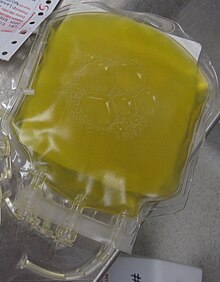Our website is made possible by displaying online advertisements to our visitors.
Please consider supporting us by disabling your ad blocker.
Fresh frozen plasma
 A bag containing one unit of fresh frozen plasma | |
| Clinical data | |
|---|---|
| Other names | Plasma frozen within 24 hours after phlebotomy (FP24)[1] |
| AHFS/Drugs.com | Micromedex Detailed Consumer Information |
| ATC code | |
| Identifiers | |
| ChemSpider |
|
Fresh frozen plasma (FFP) is a blood product made from the liquid portion of whole blood.[3] It is used to treat conditions in which there are low blood clotting factors (INR > 1.5) or low levels of other blood proteins.[3][1] It may also be used as the replacement fluid in plasma exchange.[2][4] Using ABO compatible plasma, while not required, may be recommended.[5][6] Use as a volume expander is not recommended.[3] It is administered by slow injection into a vein.[2]
Side effects include nausea and itchiness.[3] Rarely there may be allergic reactions, blood clots, or infections.[1][3] It is unclear if use during pregnancy or breastfeeding is safe for the baby.[2] Greater care should be taken in people with protein S deficiency, IgA deficiency, or heart failure.[2] Fresh frozen plasma is made up of a complex mixture of water, proteins, carbohydrates, fats, and vitamins.[1] When frozen it lasts about a year.[1]
Plasma first came into medical use during the Second World War.[1] It is on the World Health Organization's List of Essential Medicines.[7] In the United Kingdom it costs about £30 per unit.[8] A number of other versions also exist including plasma frozen within 24 hours after phlebotomy, cryoprecipitate reduced plasma, thawed plasma, and solvent detergent plasma.[1]
- ^ a b c d e f g Ko H, Lekowski RW (2013). "Blood products". In Shaz BH, Hillyer CD, Roshal M, Abrams CS (eds.). Transfusion Medicine and Hemostasis: Clinical and Laboratory Aspects. Newnes. pp. 209–212. ISBN 9780123977885. Archived from the original on 2017-09-23.
- ^ a b c d e "Plasma Intravenous Advanced Patient Information - Drugs.com". www.drugs.com. Archived from the original on 11 January 2017. Retrieved 10 January 2017.
- ^ a b c d e British national formulary : BNF 69 (69 ed.). British Medical Association. 2015. p. 172. ISBN 9780857111562.
- ^ Schwartz J, Padmanabhan A, Aqui N, Balogun RA, Connelly-Smith L, Delaney M, et al. (June 2016). "Guidelines on the Use of Therapeutic Apheresis in Clinical Practice-Evidence-Based Approach from the Writing Committee of the American Society for Apheresis: The Seventh Special Issue". Journal of Clinical Apheresis. 31 (3): 149–162. doi:10.1002/jca.21470. PMID 27322218. S2CID 866923.
- ^ Joy MA, Eshraghi Y, Novikov M, Bauer A (2015). "Transfusion Medicine". In Sikka PK, Beaman ST, Street JA (eds.). Basic Clinical Anesthesia. Springer. p. 102. ISBN 9781493917372.
- ^ Aglio LS, Lekowski RW, Urman RD (2015). Essential Clinical Anesthesia Review: Keywords, Questions and Answers for the Boards. Cambridge University Press. p. 218. ISBN 9781107681309.
- ^ World Health Organization (2019). World Health Organization model list of essential medicines: 21st list 2019. Geneva: World Health Organization. hdl:10665/325771. WHO/MVP/EMP/IAU/2019.06. License: CC BY-NC-SA 3.0 IGO.
- ^ Yentis SM, Hirsch NP, Ip J (2013). Anaesthesia and Intensive Care A-Z: An Encyclopedia of Principles and Practice. Elsevier Health Sciences. p. 147. ISBN 9780702053757. Archived from the original on 2017-09-23.
Previous Page Next Page


